|
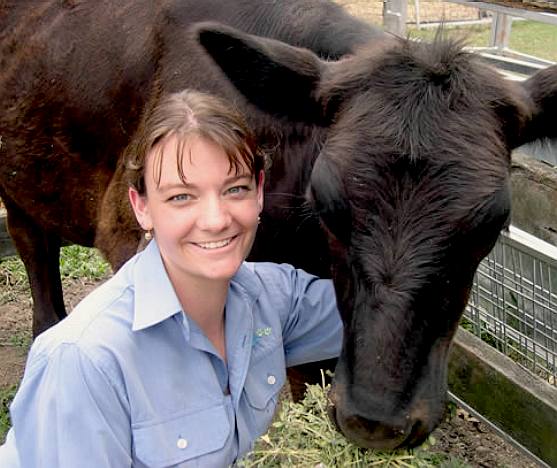
An
RSPCA worker with cows in Sussex, England.
The pay is terrible, but the rewards are worthwhile. If, that is, you
like animals.
ABOUT
VOLUNTEERS
A
volunteer is a person who gives of their time freely in connection
with a cause or activity. Volunteering is generally considered an altruistic activity and is intended to promote goodness or improve
human quality of life. In return, this activity can produce a feeling of self-worth and respect. There is no financial gain involved for the individual. Volunteering is also renowned for skill development, socialization, and fun. Volunteering may have positive benefits for the volunteer as well as for the person or community served. It is also intended to make contacts for possible employment. It is helping, assisting, or serving another person or persons without pay. Many volunteers are specifically trained in the areas they work, such as medicine, education, or emergency rescue. Others serve on an as-needed basis, such as in response to a natural disaster.
Skills-based volunteering is leveraging the specialized skills and the talents of individuals to strengthen the infrastructure of nonprofits, helping them build and sustain their capacity to successfully achieve their missions. This is in contrast to traditional volunteering, where specific training is not required. The average hour of traditional volunteering is valued by the Independent Sector at between $18–20 an hour. Skills-based volunteering is valued at
$40–100 an hour, depending on the market value of the time. Skill based volunteering includes medical internship, dental elective, teaching English etc.
Environmental volunteering refers to the volunteers who contribute towards environmental management or conservation. Volunteers conduct a range of activities including environmental monitoring, ecological restoration such as re-vegetation and weed removal, protecting endangered animals, and educating others about the natural environment.
The Giant Panda Conservation program in Xi'an and Sichuan, China, is a famous endangered animals protection program. Sichuan Giant Panda Sanctuaries conservation program attracts huge foreign support and volunteers.

Birds
that are drenched in oil should be evaluated as to the seriousness of
their exposure to toxins, before rescue treatments that may be wasted are
administered. It's a harsh world that calls for hard decisions.
DEEPWATER
HORIZON OIL SPILL - NATIONAL GEOGRAPHIC
German biologist Silvia Gaus is quoted as arguing that workers helping birds caught in the
Deepwater Horizon oil spill, should "kill, not clean." Gaus said studies show that more than 99 percent of rehabilitated birds will die anyway as a result of oil exposure, mainly due to kidney and liver damage caused by oil ingestion.
Each oil spill is different, however, and survival rates often depend on factors such as
climate and species, according to Nils Warnock, a wildlife specialist with the Oiled Wildlife Care Network at the University of
California, Davis.
No one knows what the survival rate will be for the Gulf species affected by the oil spill. But, Warnock said, "I don't believe that all these birds that are being rehabilitated for the Deepwater Horizon spill will end up dying."
He added that Gaus's statistics are related to past North Sea oil spills, where birds are more prone to freezing after oil has compromised their natural waterproofing.
Conducted in the 1980s and 1990s, the studies also represent an "old paradigm" of bird rehabilitation, Warnock said. More recent work contradicts their conclusions of poor survival rates, he added.
For instance, a January 2009 study published in the African Journal of Marine Science said that only 27 percent of oil-rescued penguins had been unable to breed following their release—a relatively low rate.
And other recent studies found that, in the United
States, 40 to 60 percent of some species of rehabilitated birds had survived after release, thanks to improved treatment, according to Roger Helm, chief of environmental quality for the U.S.
Fish and Wildlife Service (USFWS).
Over the years, rehabilitators have learned—mostly from trial and error—how better to care for injured
birds, which is particularly important for rare species, Helm added.
But biologist J.V. Remsen is skeptical of the higher survival rates, at least in the context of the Gulf oil spill. That's because the birds may have ingested toxic oil before they ever reach a rescue center.
"If the rehabbers can convince me that 25-50 percent are going to be successfully cleaned and released back into the environment and not die subsequently and painfully from the oil they have ingested, then OK, let's give it a try," said Remsen, ornithologist and professor at the Louisiana State Department of Biological Sciences in Baton Rouge.
But, he said, "emotionally painful as it is, I would be for euthanizing those birds if it can be shown that the probability of them being successfully rehabbed is low."
As of Monday, 594 dead oiled birds and 413 live ones have been collected along the Gulf Coast since the Deepwater Horizon oil rig exploded on April 20, according to the joint federal-industry response team.
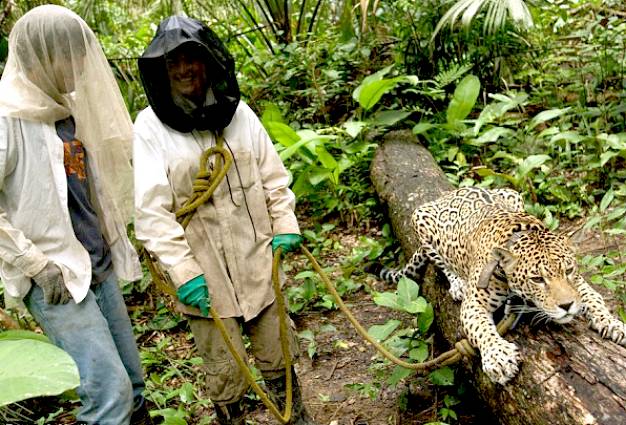
Jaguars
are related to leopards, but are usually smaller. They are no less
beautiful for that, and they are one of the most graceful of the big cats,
that seem to like water.
DAILY
MAIL - VOLUNTEERS REHABILITATE BOLIVIAN WILD CATS - NOV 2009
Deep in the heart of the Bolivian jungle an animal conservation worker wanders through the undergrowth flanked by a wild jaguar.
But this is not the prelude to a horrific attack, rather an unorthodox technique used by passionate volunteers who go to extraordinary lengths to save these often doomed animals.
The Comunidad Inti Wara Yassi (CIWY) is a unique animal rescue centre where locals and volunteers help to rehabilitate animals through direct contact.
Rescuing wild animals such as monkeys, birds, pumas, and jaguars from Bolivia's black market or abusive situations, CIWY's goals are to readapt the animals and, when possible, to release some of them within the Parque Ambue Ari.
Located in the central-Bolivian region of Santa Cruz, CIWY's 1,991-acre jungle compound has become recognised as one of the world's leading and most controversial animal rescue centres.
'We get the animals from all across Bolivia and the border with Peru,' said Karen Peter, a 45-year-old volunteer who has been stationed at CIWY for two years.
'The illegal trade and purchasing of exotic cats such as jaguars is an increasing problem in Bolivia.
'We trawl the back street markets and set up phoney deals just to get our hands on cats that have fallen into the wrong homes or hands.
'Sometimes it is just people who thought that they would make a good pet, when of course they do not.
'The trade is poorly enforced by the authorities in Bolivia and that is where we step in to correct this poor management.'
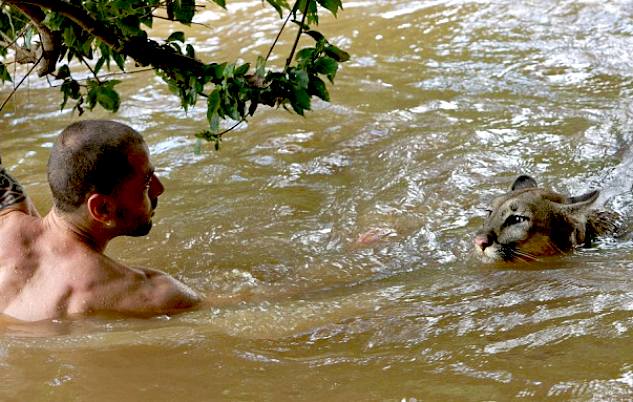
This
puma is lucky to have the care of his human companion
Each day, live-in volunteers walk these predatory felines, some weighing as much as 260lbs, on a leash through the jungle.
'When the animals are brought to our preserve in Ambue Ari they are initially put into a 40-day quarantine.
'There are 26 animals currently on our preserve, including ocelots and pumas.
'At the moment we have six jaguars.
'The animals are kept in separate large cages and are assigned volunteers to rehabilitate them.
'They are walked around outside their cage by a minimum of two volunteers at one time and a maximum of three.
'Each jaguar spends up to seven or eight hours outside the cage a day to readjust them to a semi-wild existence.
'It must be remembered that some of the animals have never spent any time in the wild and are totally dependent on humans for their lead and food.
'The jaguars are all under the age of ten and we have three boys and one girl.
'There is one jaguar who is never walked on account of his upbringing and that is Sama, who is ten.
'Nearly all of the animals will stay in the preserve as they do not have the skills.'
Founded by Juan Carlos Antezana in 1996, the Comunidad Inti Wara Yassi began as a 93-acre
jungle reserve for
monkeys rescued from homes and markets.
Located on the fringes of the town of Villa Tunari, the centre is now made up of three sanctuaries that cover 1,991-acres, where up to 40 volunteers are on site to care for the multitude of animals.
Over the past 13 years, CIWY has rescued thousands of animals, and it opened a third park this summer.
Largely funded by volunteers and private donations, the organisation does not receive monetary support from the Bolivian government. But the centre organisers say animals seized by government raids often end up in their care.
In 2006, Antezana was chosen as one of five passionate conservationists featured in Animal Planet's Jane Goodall's Heroes, and received $5,000 (£2,900) to continue his work.
Yet despite the dangers faced by the staff at the CIWY, Karen Peter is eager to point out that safety for both the animals and the volunteers are paramount.
'The volunteers are fully trained in understanding the danger signs from the jaguars - we have never had a volunteer seriously injured,' said Karen.
'Ears pricked up, wide eyes and a wagging tail are all signs to give the calm signal to the jaguar.
'The calm signal is to say "tranquilo" in Spanish and therefore instruct the jaguar to relax.
'We have never had an unfortunate accident and we don't intend to.
'The volunteers walk round with the cats for the animal's safety.
'The illegal traders know we keep around 30 animals here and they would love to come and steal them. Walking with the volunteers stops this from happening.'
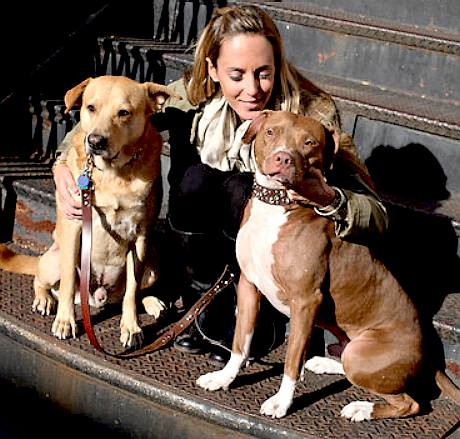
Much
as we love dogs, there are far too many without loving owners - and that
is sapping the earth's resources. Overpopulation
in humans is another problem that could lead to wars in the future if we
cannot find the food to feed them and the energy to look after them. Think
carefully before buying any animal.
NEW
YORK ANIMAL VOLUNTEERS FIGHT BACK - 2013
Esther Koslow started volunteering at New York City Animal Care and Control’s Manhattan shelter in June 2006. Koslow, who lives on the Upper West Side, spent much of her time at the city-sponsored facility in East Harlem, writing brief biographies and taking photos of the
cats and dogs there to help get them adopted.
She hasn’t worked there in four years. In 2009, the organization got a new executive director, one of 11 to take the position since 1995. Koslow saw management becoming less receptive to volunteers’ input on shelter practices, and decided it was time to move on.
Like other former volunteers at city-sponsored shelters, which take in more than 30,000 animals each year, Koslow now devotes her volunteer time to advocating for systemic change at the Center for Animal Care and Control, Inc., which operates shelters in Harlem, Brooklyn and Staten Island under a five-year, $36 million contract with the city Department of Health and Mental Hygiene.
“I couldn’t do what I do and be a volunteer there,” she said.
Koslow now serves on the board of the Shelter Reform Action Committee (SRAC), a coalition of animal advocates devoted to reforming the city-funded shelters. The committee uses its website to report on what it alleges are negligence, mismanagement and political dysfunction in the agency, sometimes using volunteers working in the shelters as anonymous sources.
Those sources are violating the agreements they signed when they came on board. Everyone who volunteers at Animal Care and Control signs away their right to talk about what goes on in shelters, so anonymity for
whistleblowers is a necessity.
Their reports are often harrowing. Manhattan Borough President Scott Stringer used their accounts in a devastating report on the shelters. “These temporary cages are always filthy — covered with feces and no food or water,” attested one former volunteer last year. “I check on these cages when I come arrive [sic] and when I leave, and they stay the same: filthy with vomit, diarrhea, dirty or no
water.”
Stringer’s report portrayed a chronically underfunded shelter system where employee negligence and unsanitary conditions lead to an infection rate of nearly 100 percent for animals after intake. (Animal Care and Control disputes the report of the infection rate, which came from City Council testimony by the medical director of the local American Society for the Prevention of Cruelty to Animals adoption center.)
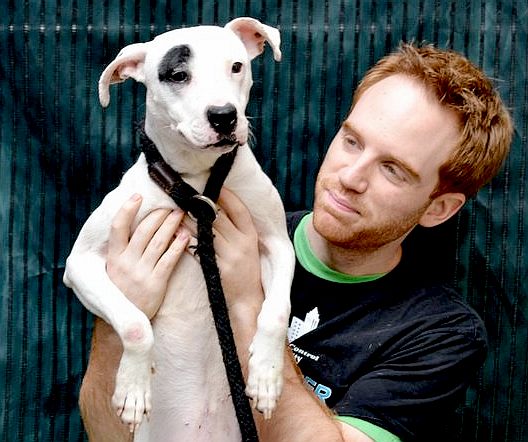
Life
is precious. Animals deserve to live their lives in conditions at least as
comfortable as they might have found in the wild. Once domesticated,
humans owe animals that are bred as pets - a good home. Humans must also
treat livestock bred for food in humane conditions. We understand that in
some counties a dog is considered good eating. We'd rather take them for a
walk and eat sheep or
cows.
It’s not what the volunteers expect when they walk in the door. They sign up to walk
dogs and socialize with them; to help out with adoptions and, sometimes, clean cages.
In an e-mail, Animal Care and Control spokesperson Richard Gentles said that more than 400 people are enrolled in the volunteer program, with about 250 classified as active volunteers.
“Volunteers play a vital role in the operation of our shelter system and we are very grateful for their support and hard work,” he said.
According to those who have spent time volunteering, however, few people show up on a regular basis to help out. Whether it’s the stress of spending time at a shelter where animals face the threat of euthanasia or the burden of working in an environment where, some volunteers say, basic needs of animals are at times neglected, turnover is high.
According to a current volunteer at Animal Care and Control in Manhattan, one ward in the shelter puts new intakes in cages right next to cages containing sick animals, on a frequent basis.
“A dog will have a post-it note on its kennel card saying ‘move to isolation ward’ and it’ll be there for five days and they’ll put a new arrival right next to it,” said the volunteer, who asked to remain anonymous because of the nondisclosure agreement. “There is no disease management or infection control.”
Gentles disputed critics’ characterizations of sanitary conditions.
“AC&C has cleaning policies, procedures and protocols in place to help limit the spread of infectious illnesses in the care centers,” he said.
Gentles said that that all kennels holding animals are thoroughly broken down and cleaned once a day or more than once if the kennel is especially dirty and that kennels are also spot cleaned throughout the day.
The Shelter Reform Action Committee advocates for a divorce of the animal shelter system — which also includes intake centers in the Bronx and Queens — from the city health department. It argues that the department is much more concerned about animal control than animal care, resulting in poor funding to Animal Care and Control and cuts in staff and service.
“If you look at the Department of Health mandate, the only mention of animals is to protect people from animals and animal diseases,” Koslow said.
Koslow and other ex-volunteer advocates favor a conservancy model for the shelter system, which would allow for an independent and expanded board of directors with more animal care expertise and the fundraising prowess.
At a debate on animal rights last week, five mayoral hopefuls — not including frontrunner Christine Quinn — voiced support for a change in city oversight of the shelters.
“Yes to full-service facilities in the Bronx and Queens, yes to a conservancy model or type of model that provides a strong, independent board with the ability to gather their own resources,” said candidate Bill de Blasio. “AC&C has been a mess. It’s been unfair to animals and unfair to everyone who cares about animals.”
One of the ex-volunteers who helped write the report, Jeff Latzer of Sunnyside, Queens, chose to lend his services at an Animal Care and Control shelter, instead of a privately funded no-kill shelter, because he said wanted to help out at “the place with the most need.”
According to Latzer, many shelter volunteers — particularly those authorized to go beyond the adoption rooms visible to the public — find that they don’t like what they see.
“You start to ask questions and you realize how little time these animals have and how few the resources that are provided to them to make it out alive,” he said.
Volunteers find different ways, Latzer explained, to try and make animals’ lives better in the shelter environment. For some volunteers this means buying extra toys and healthier food for animals. Others help out by obtaining the shelter’s list of animals to be euthanized, released every night, and anonymously posting photos and blurbs about these animals on
Facebook, begging animal rescue organizations to take them out of Animal Care and Control before it’s too late.
After Latzer spent three years and about 4,000 volunteer hours walking and socializing dogs, Animal Care and Control sent him a letter in the mail telling him that he had been “terminated” from the volunteer program for violating shelter policy and procedures, without specifying which rules he had broken.
Latzer believes he was fired because he walked dogs who had bite marks, which by policy are handled only by employees because of the possibility of rabies. (Rabies has not been found in a New York City dog in years.) Latzer also allowed other people working at the shelter to photograph him interacting with the homeless dogs in order to advertise their sociability to potential rescuers and adopters, which is against agency policy.
“They need to ‘be alone in the photo to remind people that these are homeless animals,’ which I can’t imagine someone saying with a straight face, but they put it in writing and these are the rules,” said Latzer, who says he knows other volunteers who have been fired by the shelter system.
Before being terminated, Latzer anonymously criticized Animal Care and Control practices online, but now that he is no longer at the shelter, he can attach his name to his cause.
One of his complaints about the shelters is lack of space and inadequate facilities.
“If you really want to quarantine your animals, you need to have a separate HVAC
air system going into the quarantine system, and a separate one for adoption and a third one for incoming animals,” he said. “When it’s all combined you have this stale air, which becomes a petri dish for disease and infections.”
Gentles said that the Manhattan shelter has separate zones for dog kennels, cat areas, hallways and offices, with fresh air replacing existing air in each room roughly 13 times per hour.
Stringer’s report raised questions about shelter facilities as well, calling them overcrowded. His report quoted Shelter Reform Action Committee’s blog, which details animals sitting in their own excrement and left continuously in small cages meant only for transportation. The report also noted that Animal Care has not had a full-time medical director since 2010.
Animal Care and Control has begun to make some changes on the heels of Stringer’s report. The agency is hiring new staff for several positions and creating a separate department devoted to adoptions.
Animal Care is also slated to receive a total of $10 million in additional funding from the city by next year, thanks to the City Council, which it will use to add more shelter staff and expand some existing services.
Volunteers-turned-reformers say they’re skeptical much is changing. “The AC&C has been in operation since January 1, 1995, and they just decided, oddly enough after the Stringer report came out, that ‘Gee, you know what, we should have an adoptions staff,’” said Koslow.
Both Koslow and Latzer say they will continue their fight to change the system from the outside, whether it’s by testifying at
City Council hearings or spreading the word to the public in
New York and beyond through social media. They say that the city contains enough compassion for animals and their welfare, as well as the resources and energy to make reform a reality, if only New Yorkers knew what was going on right under their noses.
Said Latzer, “Part of the priority is to start to broaden the base of people who are aware of AC&C issues.”
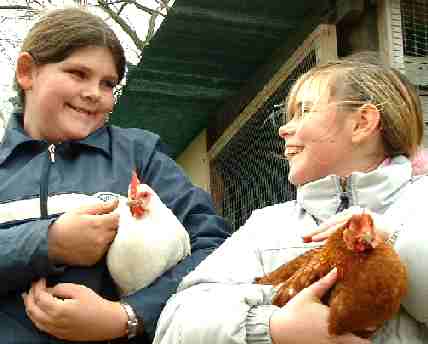
Volunteers:
Roxy and Sinead - loved
looking after these chickens (Whitey and Ginger) at the Bushy Wood animal
sanctuary in Sussex, England - Photograph © Horse Sanctuary
Trust UK Ltd (published HST 2004).
LINKS
& REFERENCE
Wikipedia
Volunteering
The
New York World animal-volunteers-bite-back
Daily
Mail Volunteers rehabilitate abused wildcats Bolivian jungle sanctuary
National
Geographic Gulf Mexico oil spill birds
http://www.rspca.org.uk/
http://en.wikipedia.org/wiki/Volunteering
http://news.nationalgeographic.com/news/2010/06/100608-gulf-oil-spill-birds-science-environment/
http://www.thenewyorkworld.com/2013/05/15/animal-volunteers-bite-back/
The
reward for our efforts and your support is the knowledge we have helped to
save so many horses. See our horses feeding, enjoying good company
and excellent care - 24 hours a day. There are many ways you can
help us with our work, and that is to give your time at an animal
sanctuary near you.
CHAMPION
| DANNY
| GUINNESS
| LACEY
| LARRY
| POLLY
PLEASE CLICK ON THE LINKS ABOVE TO SEE PICTURES OF
PREVIOUS EQUINE GUESTS
ANIMALS
LINKS:
HORSE
SANCTUARY UK LIMITED was a company with charitable objects Registered in
England and Wales No. 4593172
Their
work is continued today by Max Energy Ltd and the Horse Sanctuary Trust.
|






